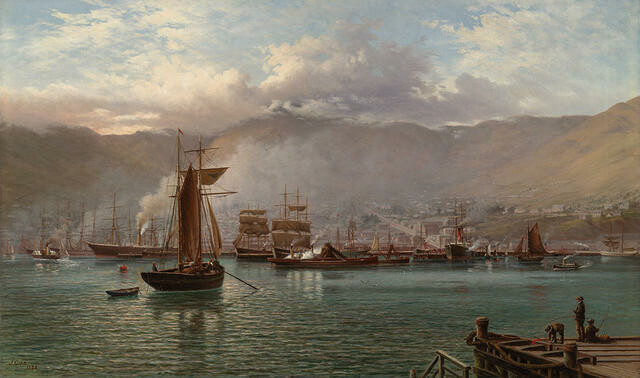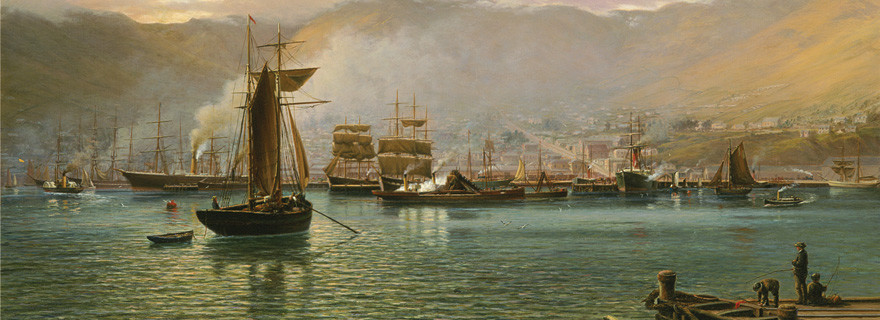Alfred Walsh and John Gibb
Alfred Walsh and John Gibb
Neil Roberts introduces two of the exhibitions in the Canterbury Vignette series: Alfred Walsh and John Gibb
Related reading: John Gibb
Exhibition
Canterbury Vignette Series: Alfred Walsh
12 February – 5 March 2000
A watercolourist of the plein air movement in New Zealand, Alfred Walsh eschewed the romantic and sentimental approach to nature. This exhibition displays Walsh's work from 1884–1913.
Exhibition
Canterbury Vignette Series: John Gibb
5 February – 5 March 2000
John Gibb, regarded as New Zealand's major professional marine painter in the 1880s, sketched from nature and later worked from these drawings to create paintings with an intense attention to detail. This exhibition explores 22 of these New Zealand paintings.
Notes

‘Where the picture stops and the world begins’
The way a work of art is framed affects our perception of the piece. A bad frame can detract and distract, a good frame enhances and even extends a work. While the Gallery has been closed we have updated frames for a number of works in the collection.
Notes

Flood in Otira Gorge by John Gibb
This article first appeared as 'Stormy weather' in The Press on 26 April 2013.
Notes

Across the Main Divide
One of the great benefits of living in Christchurch, especially post February 2011, is the amazing alpine playground that lies within easy reach of the city – the mighty Southern Alps.
Collection

John Gibb Lyttelton Harbour, N.Z. Inside the Breakwater
John Gibb’s Lyttelton Harbour, N.Z., Inside the Breakwater shows a busy port full of ships unloading and loading their cargo. By 1886, when this painting was completed, the town of Ōhinehou Lyttelton had been settled by Pākehā for thirty-seven years, and the port had become one of New Zealand’s busiest. Whakaraupō Lyttelton Harbour provided welcome refuge for ships from Te Moana-nui-a-Kiwa the Pacific Ocean beyond the harbour’s heads, particularly once the breakwater had been completed. Gibb’s painting shows fishing boats, sailing and steam ships, a launch and even a rowboat plying the sheltered waters of the harbour, busily going about their business. It was first shown at the Colonial and Indian Exhibition at the Royal Albert Hall in London in 1886, where it would have served well in promoting the progressive industry of the port and the prosperity of the Canterbury Province to an international audience.
(Ship Nails and Tail Feathers, 10 June – 22 October 2023)
Collection

John Gibb Clearing up, Otira Gorge
Referring to food rations for a tira, or travelling party, the name Ōtira originally applied to an area on the Ōtira River where provisions were gathered before journeying eastwards over Kā Tiritiri-o-te-moana Southern Alps. In 1857, led by Te Tai Poutini West Coat chief Tarapuhi and his brother Wereta Tainui, Canterbury Provincial Council clerk Leonard Harper was the first Pākehā to cross the range, over Nōti Taramakau – which was promptly renamed Harper Pass. Tarapuhi had also mentioned the largely unused Ōtira route, which was surveyed in 1864 by 23-year-old provincial surveyor Arthur Dobson. Seen as the most suitable route for linking the eastern Waitaha Canterbury settlement to the Hokitika goldfields, a road through Ōtira – and what became known as Arthur’s Pass – opened two years later.
He Kapuka Oneone – A Handful of Soil (from August 2024)
Collection

John Gibb Clearing up after Rain, Foot of Otira Gorge
From 1885 on, Scottish painter John Gibb took repeated sketching trips to Ōtira Gorge, a destination advertised in daily newspapers as offering “The Grandest Scenery in the World”. Travelling to Ōtira from Ōtautahi Christchurch at the time was quite an undertaking: a train journey to Tawera Springfield was followed by a jolting stagecoach trip through the Bealey district and Arthur’s Pass, and the accommodation options on arrival were basic. The horse-drawn travelling party pictured here had crossed Kā Tiritiri-o-te-moana Southern Alps, but were yet some hundred kilometres from their journey’s end at Hokitika on Te Tai Poutini West Coast.
He Kapuka Oneone – A Handful of Soil (from August 2024)
Collection

John Gibb Bottle Lake
Bottle Lake appears revealed at Gibb’s favoured time of day, when the sun is low on the horizon and the sky is luminous with colour. On a boat in the lake some eeling is underway. Sunlight streams across the landscape, softly striking clouds and treetops, while the grass at the water’s edge is absolutely radiant in streaks of vivid green. The scene is highly detailed and the eye is encouraged to linger on the seductive serenity Gibb has provided.
(Endless Light, 29 June 2019 – 8 March 2020)
Collection

John Gibb Shades of Evening, the Estuary
By 1880, when the Canterbury Society of Arts was formed, John Gibb was the most popular painter of the Christchurch art world. Gibb was so highly regarded that the very first work acquired for Christchurch’s civic art collection was his Shades of Evening, the Estuary. It was purchased in 1881 by the Canterbury Society of Arts from its inaugural annual exhibition and then presented to the Gallery in 1932. Gibb loved sunsets; the golden hour when there’s still a trace of day in the sky. According to one family member Gibb would drop whatever he was doing in the evening to watch and study the setting sun. His pleasure in the atmospheric effects of evening light is apparent here, as the sun’s last rays create a subtle glow on the clouds, which is also reflected in the water. The view takes in Christchurch’s Ihutai / Avon-Heathcote Estuary.
(March 2018)
Collection

John Gibb From the Foot of the Hills
Gibb's view of the Canterbury Plains from the foot of Christchurch's Port Hills highlights the agricultural potential of this vast, flat expanse. The plains are also known as Kā Pākihi Whakatekateka a Waitaha, which translates from Māori as the seedbed of Waitaha (the region's early inhabitants). The region was a bountiful food source for the people of Ngāi Tahu, providing just as it does today. The cows standing in the middle of the gentle Heathcote / Ōpāwaho river in this painting provide a reminder, however, that this land needs to be respected if future generations are to continue to benefit from what Kā Pākihi Whakatekateka a Waitaha has to offer.
(John Gibb, 18 December 2015 – 28 August 2016)


